'Le Grand Défi' by Jean Graton, first of the Michel Vaillant comics
Some reflections and even more reflections
Author
- Henri Greuter
Date
- February 28, 2023
Related articles
- The Race of Two Worlds - The 1958 "Monzanapolis" bash, by Darren Galpin
- Ferrari at Indianapolis - Mutual love unanswered, by Henri Greuter
- Michel Vaillant - The Michel Vaillant adventure Suspense à Indianapolis: Where fantasy and reality met - and about that reality, by Henri Greuter
Who?Steve Warson What?Warson Kurtis-Novi 500F Where?Indianapolis When?1957-'58 Indianapolis 500s |
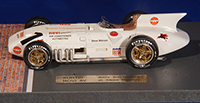 |
Why?
I must start my reflections with a disclaimer. No comment and no observation in this piece is to downgrade the work of Jean Graton. Nothing what reads as or appears to be negative must be seen as negative. I have no reason to be negative about Jean Graton and his work because I am one of the many readers of his albums who owes a lot of his interest for motor racing to the albums that he created. And I have more reasons to credit Le Grand Défi as the inspiration for all that.
If there were a Hall of Fame for those who have promoted motor racing among the youth, I will nominate Jean Graton instantly. So, please read all this as observations, comparisons and evaluations as they are and not as criticism.
Secondly, I believe it is very likely that elsewhere similar articles have been published about the Vaillant albums, if not in English, then in other languages. I hereby want to state, maybe must confess, that I have not done a detailed search for such pieces, so if there are any, I simply was not aware of their existence at the time of writing the initial version of this piece (first half of 2017). The first version of this article was published on the Autosport Nostalgia Forum on July 23rd, 2017.The version presented here is an updated and extended version. The title reflects the contents: Some reflections was the title of the original 2017 version. The and even more reflections part refers to all the updates found since and presented in the version presented here.
Finally, this writing would probably benefit from the inclusion of drawings from the album that is discussed here. However, due to wanting to honour and respect the copyrights of the author and the current copyright holders I can't bring myself to doing so.
Reflecting on the very first album of the Michel Vaillant series leaves a number of thoughts and questions. Michel debuted in the comics for the first time in early 1957 when five short stories were printed. The very first full album Le Grand Défi appeared in 1959, after having been published in the Belgian weekly magazine Tin-Tin during the best part of 1958.

The cover of the different prints and versions of Le Grand Défi over the years looked like this, permitting slight varieties in color over the years. Here is a rather rare version, the one used for the English translation that was published by Graton Editeur in 2007.
Certainly with hindsight and more knowledge about the actual situation of that time, the album creates a number of questions if it comes to its origins and exact timing.
The plot in short: French car builder Henri Vaillant has two sons Jean-Pierre and Michel and owns a car company. The cars are named Vaillante. Apart from passenger cars and trucks, the company also builds racing cars designed by Jean-Pierre and driven primarily by his youngest son Michel.
Before the album starts, an American newspaper had difficulties with granting Juan Manuel Fangio the title of World Champion while doubting that any European driver was capable of doing well in the Indianapolis 500. The Vaillants, together with a friend of father Henri, Louis Latour, who is the publisher of a newspaper, then challenge the Americans to nominate a driver and have him and Michel contest a series of five events on the calendar for the title of 'Best driver in the world'. The events are a Formula One race in Argentina, the Indianapolis 500, the Formula One race at Spa-Francorchamps, the Le Mans 24 Hours and finally the Formula One Grand Prix at the Nürburgring. All of this is explained once the story has started.
The album starts at the moment the Vaillants find out that the Americans accept the challenge. The events subsequently take place, and all of that, and more, is told in the album. Graton blends a lot of the truth into his plot. Apart from the Vaillantes used by Michel there are not that many fictitious cars in the story. Although the majority of drivers have names that do not correspond with a real person, a few of them were active drivers at that time. Michel's opponent in the challenge is Steve Warson, a fictional character.
The plot and the mere idea of the challenge as offered by Graton looks outrageous and fantastic, but there have been a few events in both 1957 and 1958 that were inspired by things happening earlier in 1957 and that may also have been the inspiration for Graton's fantasy story.
In June 1957 we saw the Race of Two Worlds, organised by the track owners at Monza, which had been extended with a banked high-speed oval. They had invited the ten best American Champ Car drivers (best known from the Indianapolis 500) and their cars to compete at the Monza oval against the best that Europe had to offer. Indeed, ten cars and drivers and teams came over but despite the initial enthusiasm among the European drivers, eventually the Formula One drivers boycotted the event which they rated as too dangerous and too fast, in the process evoking a fair few comments by members of the European and American press.
Most outspoken of all was Floyd Clymer, a publisher in Los Angeles who had released a number of books in the years since the war. One of his most important prints every year was the Indianapolis 500 yearbook. He was neither into newspapers nor magazines. Clymer truly went after the reigning World Champion Juan Manuel Fangio by stating that no driver who refused to go against the Americans on their own game, be it at Monza or Indy, was a worthy World Champion. So in the aftermath of the 1957 Monzanapolis he did two remarkable things. First he tried to raise funds to have the brave Scottish drivers in who had dared to taken on the Americans using their Jaguar D-types. Second, he challenged Fangio that he (Clymer) would pay Fangio $500 should he enter the 1958 Indianapolis 500, pay another $1000 should Fangio qualify for the 500, and yet another $2500 should he finish in the top five in an American-built car, and $5000 should he finish in the top five in a European-built car.
Some of this was printed in the English press, but it can all be found in the Monza 500 section of Clymer's 1957 yearbook. For those who are familiar with Le Grand Défi, all of this must read as vaguely familiar, right?
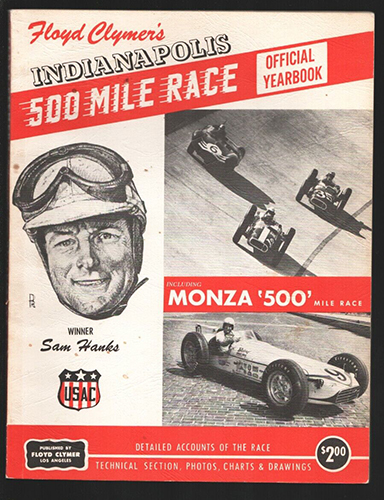
Scan of the front over of the 1957 Floyd Clymer Indianapolis 500 Yearbook. A section of the book was devoted to the 1957 Race of two Worlds at Monza.
What eventually happened was that Fangio did appear at Indianapolis in May 1958, and was initially assigned to the George Walther-owned Kurtis Offenhauser. The required chemistry wasn't there and Fangio doubted the quality of the team. He then tried the yet unassigned number 54 Kurtis-Novi for which he could rely on all his experiences with the also mechanically supercharged BRM V16. The first test laps were promising but eventually Fangio did not accept the offer to try to qualify. Instead he gave up on the plan to do Indy and went home. Floyd Clymer was good to his word and handed Fangio the awarded $500 for having entered. Fangio donated the money to charity. The reasons as of why Fangio did not try any further after that are beyond the scope of this write-up. It should be mentioned, however, that Mike Magill eventually did qualify the Walther-owned car and that Bill Cheesbourg did qualify the Kurtis-Novi, two more stories in themselves beyond the scope of this work.
That was what could have been called the true Grand Défi, as far as it came.
The Race of Two Worlds wasn't to be a long-lasting event, as the end came after just two occasions. Both cars of the overall winners (each event consisted of three heats) have survived.
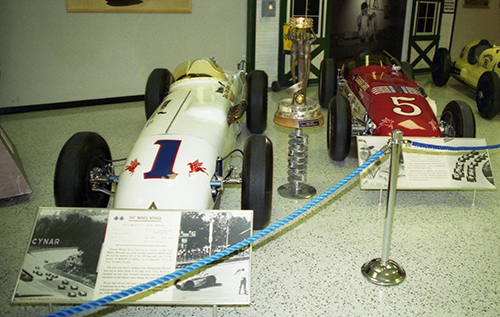
Seen here in late 2003, the two overall winning cars of both Races of Two Worlds. The #1 Dean Van Lines is a Kuzma-Offy, driven by Jimmy Bryan in 1957. The Zink Leader Card #5 is a Watson-Offy driven by Jim Rathman in 1958. Between the two cars stands the trophy presented to Jimmy Bryan. (Photo HG)
Jean Graton has stated the following about Le Grand Défi: "I wanted to put everything in The Great Challenge. My hero, his family, Formula One, the 24 Hours of Le Mans, Indianapolis, up to the hero offering his blood to the injured opponents."
For this first full Michel Vaillant adventure, Graton did a lot of research. He knew the circuit of Le Mans since his childhood. He went to the track with Pierre Stasse, the director of the magazine Les Sports but who was also with the Equipe National Belge. Graton did not have the opportunities and means to travel to Indianapolis, so instead he wrote to Bill France, the director at Indianapolis who sends him books and photographs.
Curiously, these printed statements about Indianapolis can't be 100% correct. But I have received exactly the same answers many years before in private correspondence I had with Jean Graton for one of my own projects. What raises my eyebrows about this answer is the fact that Bill France has never been involved with, let alone has been the director of the Indianapolis Motor Speedway. France was totally and entirely focussed on racing with production-car-based racing cars (stock cars) and his NASCAR organisation has never ever done anything with open-wheel racing. Even sports car racing was something they (at least initially) did not want to have anything to do with. Bill France wanted to make racing production cars work and be in control of. There was already something of a rivalry between France's NASCAR organisation and the USAC which sanctioned the Indianapolis 500, a feud that USAC had inherited from their predecessors AAA.
So if Jean Graton has corresponded with someone who was related with the Indianapolis Motor Speedway, it must have been with someone else. Or, if he had indeed been in contact with Bill France, then it is kind of remarkable that France has been of so much assistance to Graton about an event and facility that he (France) did not care about and had nothing to do with. Graton's plot in the comic is of course much more interesting and in reality could have been quite something…
Interesting detail: the entire album Le Grand Défi contains no reference to the official World Championship for Drivers as was taking place at that time, As generally known, the World Drivers Championship was organized for Formula One cars and the Indianapolis 500 was added to the championship to have some American influence. This World Drivers Championship was open to any competitor participating, Le Grand Défi, however, is a duel between Michel Vaillant and Steve Warson only, no other drivers are eligible for this title of 'the world's best driver'. For the contest, the driver who scores the best result in any of the events wins that element of the contest, an overall victory is not required. By the way, all Formula One events in Graton's Le Grand Défi as well as Indianapolis did all count towards the World Drivers Championship.
So in what year could this Grand Défi have taken place?
With the album appearing in Tin-Tin magazines published in 1958 and the album being released in 1959, the question arises in exactly which year Graton's adventure supposedly took place. There is no mentioning of a calendar year anywhere in the story. The first thoughts are that if the full story started to appear in the very first edition of Tin-Tin magazine published in 1958, the story is created in 1957 and thus has to be a 1957 adventure. But there are a number of details in the plot and elsewhere that suggest this to be a 1958 adventure. The evidence that I found for 1958 (and there may be a few more) are:
1) In the third race of the contest, the Belgian Grand Prix for Formula One cars, it is mentioned that a rule change has been introduced which forbids the use of all kind of fuel blends and mandates the use of regular, commercially obtainable fuels. This rule change came in effect from 1958 onwards.
2) In the real world, there was no Belgian Grand Prix at Francorchamps in 1957 but there was in 1958.
3) In the final race of the contest (the German Grand Prix) there is talk about Steve Warson beating Juan Manuel Fangio's lap record. Fangio did indeed own the lap record after the 1957 German GP, set in the memorable race in which he made a pit stop for tyres and fuel and passed Mike Hawthorn and Peter Collins on the last lap.
I assume that specialists in the history of Le Mans, be it in general or specialist in car brands that have participated at Le Mans, may find some clues to either '57 or '58 in the Le Mans section of the story.
As mentioned, no clue can be found in the story to pinpoint the exact year in which the story takes place. There is, however, one possible clue in the 20th album of the series. The original title for that album is Rodéo sur 2 roues, released in 1971. In some drawings of meetings held in Henri Vaillant's office we see a print hanging on the wall that features the car that Michel drives in the first two events of Le Grand Défi. In one of the drawings a trophy can be seen that resembles the Borg-Warner Trophy. But the poster also has a year on it: 1957. For those who own this album, take a look at the following pages:
Page 7: row 4, first drawing.
Page 8: row 4, first drawing. (I believe that I can actually read the text 'Indiana' and '19' on the left side of the poster and 'polis' and '57' at the right.)
Page 10, row 2 and row 4, second drawing at both rows.

Detail of a scan made from page 8, row 4, drawing 1 from the album 'Rodéo sur 2 roues'. The best proof for Le Grand Défi taking place in 1957?
So, was Le Grand Défi an event that had taken place in 1957? Or had Michel driven this car before in events in 1957 that weren't covered by any album and won a race worth remembering in the board room of Henri Vaillant? And the trophy on that poster was resembling but not actually being the Borg-Warner?
Another clue on the Graton Editeur website is to be found on the Collectables page. Among a number of models of cars appearing in several albums made by Jade Miniatures a model is featured of a car that appears in the third and fifth race of Le Grand Défi, designated to be the Vaillante 571B. (The car in the first two races of Le Grand Défi must have been the 571 or retrospectively the 571A.) In addition to that, the very same car that ran in the last two GPs of Le Grand Défi also appeared in the second album, as well as a brand new car introduced later during the year. Both the cars are given a 1958-inspired type registration.
In addition to that: Jade Miniatures also released models of the two Vaillante sports cars that appear in the adventure. These also get a type registration that hints to a car built in 1957.
Finally, there is one more clue that suggests that the adventure took place in 1957 but the main subject related to that clue will be discussed later on, so let's not run ahead of ourselves.
However, against all of these 1957 claims are the imaginary lists of achievements by both Steve Warson and Michel Vaillant that are also on the Graton Editeur website and in which both drivers have their achievements obtained in Le Grand Défi listed as having taken place in 1958.
To add even more confusion to the actual year of the events taking place, an English edition of Le Grand Défi published in 2007 contains a lot of drawings of Vaillante cars that appeared in the various albums over the years. One of these cars actually appears in that same The Great Challenge but the type registration suggests that it was built in 1959! That for me is the one clue that I disregard instantly, only mentioning its existence. Maybe the car was credited as a 1959 model because of the original French publication having been released in 1959?
Then we have a few final clues that leave a thought or two. One of the very few drivers alive and participating in F1 at that time and who appears in Le Grand Défi with his own name and actually winning the third race of the contest is Peter Collins. The next GP of the contest (the fifth and final event of the challenge) is the German Grand Prix at the Nürburgring. Now, if Le Grand Défi is indeed an 1958 contest, it means that Jean Graton had Peter Collins win the Belgian Grand Prix but not mention Collins any further in the story, and maybe for good reasons, as in the actual 1958 German Grand Prix, Collins was fatally injured in a crash at Pflantzgarten. There is indeed a massive accident taking place in Graton's version of that German Grand Prix but it doesn't result in a fatality.
Then, shortly before the start of that German GP, Graton has the organizers of the event pointing out that the racing season had been a tough one, marred by a number of fatal accidents. A minute of silence is held to honour these drivers. The 1958 season indeed saw more fatal racing accidents than 1957.
So we are in the situation that it is difficult to come to a final verdict on the year that Le Grand Défi has taken place. There is enough proof for both years, 1957 or 1958, often with one clue supporting one year while excluding the other.
I for myself no longer want to make any definite claims towards the exact year in which Le Grand Défi must be placed. But going through the album as well as real history, there are a number of interesting things to tell about Jean Graton's work: when he used the actual truth, created something inspired by the truth or made something up entirely by his own fantasy. Let's have a closer look at that.
The personalities appearing in the album other than the Vaillant family
As for drivers who appear in the album that did exist, Lucien Bianchi and Peter Collins are the only two that I found. Finally, there is mention of a certain Swaters, the co-pilot of Bianchi at Le Mans. This must be Jacques Swaters. Other drivers who are mentioned by name in the story are inspired by people in the publishing companies that Graton worked with.
Curiously, despite the first event of Le Grand Défi taking place in Argentina, no single mention is made of Juan Manuel Fangio as a participant in any of the races. Even if we assume that Le Grand Défi was a 1958 adventure and consider the fact that Fangio did retire from racing during that year, he was still active during the best part of the time period in which Le Grand Défi took place.
The fictional character Steve Warson is nominated as the American contender for Le Grand Défi, much to the surprise of French newspaper president Louis Latour, the man who the challenged the Americans together with the Vaillants. He had expected a man like Pat Flaherty of Sam Hanks.
Both these names were taken from the real world, in fact, they might ring a bell. They were the winners of the Indianapolis 500 in 1956 (Flaherty) and 1957 (Hanks). But it is very unlikely that any of these two men could have been selected for real. Flaherty had been seriously injured some three months after his Indy victory and as a result was unable to do any racing in 1957. He returned to racing as late as 1959 but his career was pretty much over after that injury.
Sam Hanks won Indy in 1957 and once in Victory Lane tearfully announced his retirement from racing. He had won the ultimate prize and that was it. He got a lot of praise for his decision, something a fairly recent F1 World champion certainly failed to get after doing the same...
Hanks did honour the contract that he had for a few stock car races that year but his participation in the world of Indycars after Race Day 1957 was as an official or a celebrity ever since. Let's say that Louis Latour wasn't as well informed as he appears to be at first sight…
Instead the American contender nominated for Le Grand Défi is Steve Warson, a capable driver said to be very unsympathetic. In reality, I think that any American driver who accepted to compete in Le Grand Défi would have been rather surprising. Many of the best American drivers and those most known in their home country were not interested in leaving their country to compete abroad. Certainly the best of these drivers were racing not just for the sport but also because they could earn enough money to make a decent living. And the prize money in American races was generally higher then what could be won in European events. Thus it was very rare that top-line American drivers made it over to Europe. Since there was no prize money to be won in Le Grand Défi, we must wonder what kind of financial reward or compensation Steve would have got (and from whom!) for participating in the contest in addition to the prize money that he would win at Indianapolis. Graton offers no answers to those questions. At best he left maybe one single clue. Warson is surrounded by his own crew that maintains his cars during all the races. They have his name (Warson) in large red letters on the backs of their overalls, as if Steve was a sponsor. Does this mean Steve is wealthy enough to have gathered a crew of people around him to support him and his cars during the contest? Anyway, he certainly doesn't match the common profile for the Champ Car/Indycar formula driver of the late fifties, as the majority of them were hired by a team owner who first bought the car(s), found sponsors and only then hired drivers as well as a chief mechanic and other crew members. I will get back on why I talk about cars in plural, there is a good reason for that.
About the cars driven by the two contenders
Then, what about the cars used by the two imaginary drivers Michel Vaillant and Steve Warson? For Michel, this was easy. His father owned a car-manufacturing company, Vaillante, and this company built an F1 car as well as a Le Mans sportscar, and for both cars Graton could use his imagination. For the F1 car he found his inspiration with the French-built Gordini cars, as the F1 Vaillante resembles the Gordini. Given the French heritage of Gordini and it being one of the very few French influences in F1, it's not strange that Jean Graton fell back on the Gordinis for his inspiration: 'Vive la patrie!'
The car is named Vaillante Grand Prix and Michel uses two different examples in the three F1 events. The first car competes in the F1 race in Argentina, the second car is introduced during the third event, which is the second F1 race held at Spa-Francorchamps, and it's also used in the fifth and last event of Le Grand Défi. That is the third GP race held at the Nürburgring. More about why the second car was pressed into service later on.
About the sportcar used at Le Mans, the fourth event of Le Grand Défi, I'll get to that one later as well.
Steve Warson had the difficulty (at least for Jean Graton!) that there was a lack of American-built F1 cars. The Scarab F1 had yet to make its first appearance (in 1960). But Graton refused to create an imaginary F1 car and so he had Steve relying on what had become a proven concept by then: a Vanwall, the kind of car that had got its act together during 1957 and was breaking the stronghold of Italian constructors in F1. Steve's car was painted all white in the first race but it gets a blue stripe in the remaining F1 races, so almost matching the American racing colours of white with two blue stripes.
The one thing that could be held against this selection for a Vanwall is the fact that the creator of the Vanwall team (Tony Vandervell) was a patriot and raced for the glory of Britain and the dream to beat the almighty Italian teams. Somehow, I wonder if the real Mr Vandervell, in case of a Grand Défi according the formula of Graton would have provided an American competitor with a car. And I am pretty sure that a number of British patriotic race fans would have had a heart attack or worse after seeing one of their beloved pieces of 'British pride' in any other colour other than British Racing Green. But then, there was little other choice for Jean Graton.
BRM (short for British Racing Motors) was name-wise already near impossible to use for an American driver, apart from the fact that BRMs had not done much yet to set the world alight. They had yet to win their first ever GP when Graton drew Le Grand Défi.
It is very doubtful that Ferrari would have supplied a car, which leaves only Maserati. Now, that company had built enough cars to provide one to just about everyone who wanted to be a Formula One driver. So...
To supply Warson with a suitable car for Indianapolis was little to no problem at all for Graton. Initially it is told within Le Grand Défi that Warson will race a Dean Van Lines Special, the car in which he had won an earlier edition of the '500'. A drawing of Steve sitting in a bright red Dean Van Lines Special appears in the album.
In reality, the Dean Van Lines Special did exist, but never did any car using that name win at Indy. The name came from the team owner and main sponsor of the team, Al Dean. He was the owner of a trucking company, Dean Van Lines. The car that raced under that name was a tube-frame chassis built by car builder Eddie Kuzma and was powered by with Indy's ubiquitous engine at the time, the 4.2-litre Offenhauser four-cylinder with the equally near-standard Halibrand two-speed gearbox. Kuzma built the car during the winter of '55-'56 and it was raced by another famous driver of that era, Jimmy Bryan. Although Bryan never won at Indy with this car, he did win another famous race with it that plays a part in the coming together of Graton's plot for Le Grand Défi. Bryan drove the Dean Van Lines Special in the 1957 race at Monza and was the overall winner of that event. At the end of the season, however, he left the Dean Van Lines team and switched to the team of George Salih who fielded the Belond Special. That was the car that had won the Indianapolis 500 in 1957, driven by Sam Hanks. Bryan made a good decision: he won the 1958 race in the Belond.
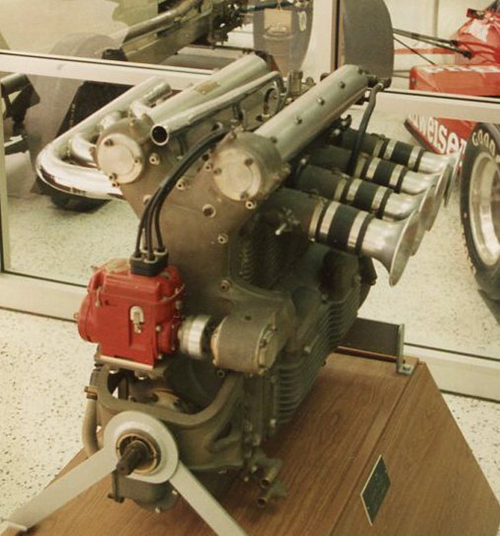
Seen in the IMS Museum in 1988, an example of the venerable Offy engine. Since 1938 used in 4.5-litre trim, from 1957 on reduced to 4.2-litre capacity. The majority of the cars that were raced in the Indy 500 between 1946 to 1963 used an Offy as its powerplant. (photo HG)
On page 15 of Le Grand Défi, bottom row, last drawing on the page, we can see the start of the race with a pink Belond Exhaust Special at the very right of the drawing. That car does not resemble the real Belond very well. Curiously, its colour would make Indy specialists associate the car with another famous entrant of that era, John Zink, who entered the John Zink Specials, the winning cars in 1955 and 1956. And 'the Zinks' were pink! The real Belonds were yellow.
Yellow, just like the number 3 in the very same drawing, the car that wears the name Dean Van Lines. The true Dean Van Lines cars, however, were white. By the way, after Jimmy Bryan vacated the car, it was driven in 1958 by a young upcoming Texas driver who debuted in the Indianapolis 500 that year and would become a legend of the Speedway in the 35 years that followed. He was a contender in all of those 35 races! His name: Anthony Joseph Foyt, better known as AJ...
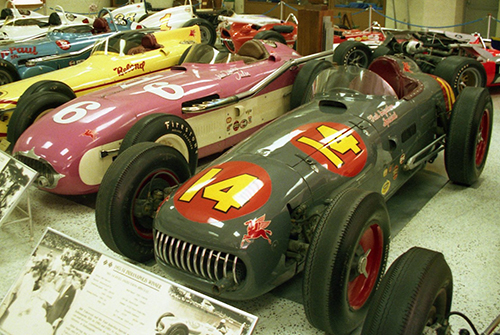
Seen in May 1988, the grey 14 is the first of the so-called Indy roadsters, the typical built-for-Indianapolis racing cars. Bill Vukovich won the race in 1953 and 1954 with this car. Next to it the 1955 winner, a John Zink Special, the truly pink cars at Indy in the fifties. Just visible is the Belond Special that was indeed yellow. (photo HG)
Now those are a lot of details about cars that Steve Warson eventually never drove in the race! There is no explanation offered in the text but when the race is about to begin, it is told that Warson will start the race in a Novi Special. In the Dutch translation of the album it is described as a powerful car. In the English translation published in 2007 it is mentioned that the Novi has a compressor. Steve's Novi is white and wears the number 1. It is this number that offers an indication how successful Steve Warson was as a driver. Although there is a good chance that Jean Graton was not aware of this and unintentionally made Warson an even more successful driver then he had in mind.
During the fifties it was a tradition that the reigning National Champion wore the starting number 1 next season if he wanted to do so. Due to the points system used in the championship, it happened fairly often that the Indy winner also became the National Champion but it was no certainty. In fact the true National Champion in Champ Cars in 1958 was Tony Bettenhausen but his title was to some extent tainted because he failed to win a single race during the entire season! At Indy he finished fourth that year. Anyway, starting with the number 1 meant that Steve was the champion of the previous year but doesn't mean that he also won Indianapolis that year.
Come to think of it, there is a good chance that Jean Graton was unfamiliar with this tradition with the number 1, so Steve's National Championship was probably entirely unintentional!
And since we're talking numbers, Michel's car is numbered 8, in reality almost impossible to obtain, since the starting numbers below 10 were reserved for the drivers who had finished in that position in the overall standings of the previous year.
Now more about Steve's eventual race car, a Novi Special. We already saw that Juan Manuel Fangio test-drove a car named Novi in 1958 and indeed, the Novi that Graton introduces is derived from the existing cars that ran using the Novi name. Now, I can tell (way too) much about those cars and their history. (Proof needed? Here we go.)
The Novi differed from any other Indycar of its time. While just about every Indycar, no matter who had built the chassis, still used a 4.2-litre Offenhauser four-cylinder, the Novi cars were powered by the Novi 2.8-litre V8 with a centrifugal supercharger. Despite a power advantage of at least 125 or more hp on every other opponent, Novis had never won a race at Indy, one third place (1948) was their best result. At the time that Le Grand Défi took place, the Novi cars used a tubeframe built by Kurtis-Kraft in 1956. Since this was the sixth variety of this series of Kurtis-Kraft tubeframes for Indycars, the type registration for this variety was Kurtis-Kraft 500F, but just about everyone called them the Novi Roadsters at that time.
The Novi's main problem was that the cars were caught in a vicious circle of needing much more fuel to produce their power advantage. So they were much heavier, as a result of that wore out their tyres much faster for which at least one more extra pitstop had to be made, and to compensate for that the cars had to be driven faster for which they needed more fuel, etcetera, etcetera. That is, if there were no mechanical failures first and mishaps during qualifying which had prevented the cars to even qualify for the race! The cars had so many moments of what appeared to be bad luck or did suffer from misfortune that they were considered to be jinxed.
But the cars could leave the fans speechless by their performances. Warson’s Novi was inspired on a car that made its debut in 1956. During practice that year there was speculation if the 145mph lap average barrier could be broken. When Novi driver Paul Russo did it he went over 146 at the same time! But on qualifying day that speed was gone so he eventually ended up in eighth place only with what had been by far the fastest car that year. In general, it could be said that the cars could be devastatingly fast if everything was fine and well sorted out. But those outbursts of speeds were only possible over a limited amount of laps. During the entire race all the speed potential had to be applied utterly carefully in between the stops for fuel and tyres in order to preserve the tyres.
Despite their lack of success, their tremendous noise and engine tone turned the Novi cars into crowd favourites. I think it is fair to state that the popularity of the Novis among the Indy fans, no matter who drove them, was comparable to the popularity of Ferrari in F1 then and now.
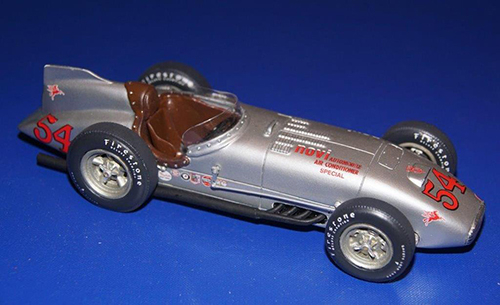
Regrettably, I never saw either of the Kurtis-Novi 500Fs in real so I can't add a self-made picture of one of them. Besides that, one of the cars doesn't exist anymore and the remaining car looks a bit different compared to its looks in the late fifties. So the best I can do is show a picture of a 1:25 scale model of one of the cars. This is a model of one of the cars as used in 1958, driven in practice by Juan Manuel Fangio but eventually qualified and raced by Bill Cheesbourg. (photo HG)
As for their colours, while Belonds were yellow, Zinks were pink and Dean Van Lines were white, Novis were chameleons. Over the years they sported all kinds of colours, each and every year a new one, in the years when two cars were entered those also often differed in colour from another. Only once in their history, a single Novi car retained the same primary colour one year later. White had been used once. That's it for the time being about the actual Novis.
Graton has declared to me in a brief message that he selected the Novi for Steve because he felt that it was the kind of car that matched a man like Steve.
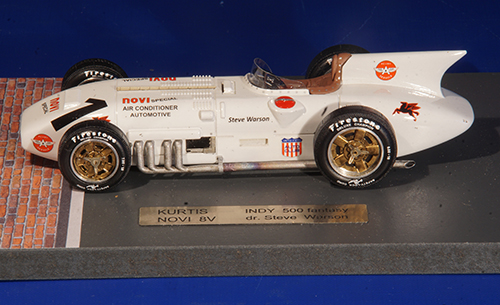
Italian company Ostorero built 1:32 scale slot cars versions of the 1956 Kurtis 500F-Novi cars that raced at Indy that year. The model was then also used to create Steve Warson’s Novi in Le Grand Défi. Colour and decal-wise the match is good. However, the car has too many details of the real cars to perfectly resemble the car in the album. Still, a good effort. (photo HG)
A good observer will notice that the tail fins on the models of the two cars in the pictures above are different. As mentioned, the model of Steve's 'White 1' is derived from the real cars used in 1956 modelled by the company. And indeed, the tailfin on the model is resembling the design that the Novi's used in both 1956 and 1957. But the fin was modified from 1958 on as the 1958 model correctly shows.
So the fin on Steve's Novi as drawn by Graton is indeed historically correct for a 1957 Novi. And that is the last clue or maybe even piece of evidence I was yet to mention as to why Le Grand Défi is supposedly taking place in 1957. Besides that, when the adventure went into print in TinTin magazine, the 1958 Indy 500 had yet to be held…
Going back to Steve's 'Big White One' in Le Grand Défi, other than the aforementioned details, there is no information whatsoever given about the Novi. In a drawing of the race we can see that Steve still has his own crew to support him during the race, which definitely could not have happened in the real world. In reality during the fifties, the Novi engines and their cars were owned by Lew Welch, a business man from Novi (a suburb of Detroit), Michigan and the engines were exclusive to him. His team was based in California and at no time he entered more than two cars. I write 'entered' since Novis were for all kind of reasons (some entirely logical, sometimes bewilderingly bad luck) never certain qualifiers for the actual race, despite having 125hp over their opponents.
The two existing Novis also went to Italy for the aforementioned 1957 Monza race. In practice one of the cars blew its clutch and was unable to start the race (typical Novi luck) while the other car took pole position but was the first retirement... (Must I really repeat myself?)
Knowing what I know about Lew Welch, I seriously doubt that he would have made any of his cars available to a driver like Steve and have it serviced by a crew that Steve had organised himself. The Novi engines were notoriously tricky to deal with and would have required team specialists to assist Steve's men. At best I can envision that Steve would have found a way to obtain a drive in one of Welch's cars and 'amalgate' his own team with that of Welch for at least Indy.
Anyway, there is not a shadow of a doubt that although it came after a change of heart Graton eventually selected by far the most intimidating of all Indycars of its time for Steve. One thing, however, was missing to make it match with Steve for the full 100%. Steve was a successful driver, the Novis on the other hand were certainly no successful cars. Their owner, Lew Welch, while searching Victory Lane at Indy with his cars and their legendary engine, he only found the Boulevard of Broken Dreams at the Speedway grounds.
Maybe this is also the right place to give detailed attention to the car that Michel drove at Indianapolis. While Graton had ample choice for selecting a car for Steve that was inspired by a real car, for Michel he had to use his imagination for more than simply the fact that the car was built by Vaillante. The F1 car used at Argentina is modified for use at Indy by putting on new tyres, putting the engine more to the left within the chassis and installing fuel injection. Nothing else...
Formula One cars in that era had a 2.5-litre engine, the number of cylinders was free. This 2.5-litre era, which lasted from 1954 to 1960, saw a large variety of engine configurations, from four-cylinders, six-cylinders and eight-cylinders, in-line as well as in a V, and even a V12. In 1957, the power output of all these different engines was anywhere between 250 and 300hp.
The Vaillante had a straight-six engine, that much can be made up from the drawings of the car.
The Offenhauser-powered Indycars that the Vaillante was up against had close to 400hp in qualifying and 350 to 370 or thereabouts in the race. Fuel injection, still a rarity in F1, was by then a piece of near-standard equipment on the Offy four-bangers. At that time, only one team was experimenting with a supercharged 2.8-litre version of the Offy and had about 460hp. The Novi V8 was rated at anything between 525 and 575hp and still used a carburettor, a model derived from a type used on aircraft engines.
Indianapolis as it was at the time of Le Grand Défi
I must give more attention to the actual situation at Indy as it was at that time, in order to explain a few things already told and yet to be told. For those unfamiliar with Indianapolis in the fifties who wonder why there weren't any more teams opting for the much more powerful supercharged engines: first of all these engines were far more expensive in a time when there were no factory-supported efforts in Indycars. All participating teams were privateers that bought what was available and supplied by small specialist companies and individuals. There were no big sponsors with massive cash flow either. There was a National Championship for the cars also used at Indianapolis but it wasn't called the IndyCar Series yet. In general, the series was named National Championship and the cars were 'Big Cars'. The majority of events for this National Championship was held on dirt tracks, so unpaved ovals. These tracks required a far more simple yet rugged car, so many teams owned two different cars for the season: the dirt car for most of the races in the championship and a second car specialised for use at Indianapolis and the other paved ovals. But one of your hands has more fingers than the presence of other paved oval events in the Champcar series. This 'special for Indy' car had been a fairly recent innovation. The first of them debuted in 1952 and since 1954 it had become the preferred type of car for Indy. But despite fielding two different chassis during the season, just about every team used the same engine all year long for both their cars during that season, as the Offenhauser four-cylinder fitted the job perfectly. Although the Offy had less power than supercharged engines, it had a massive amount of torque which when used at Indy enabled the car to have a tremendous acceleration out of the corners. And this made up quite well for the lower top speed. So overall, the atmo Offy was the ideal compromise for the majority of the competing teams at that time, the more while it was readily available to anyone who wanted them and could afford them.
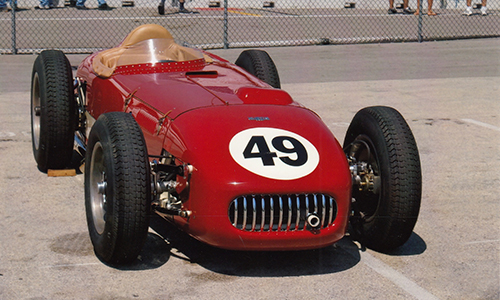
Seen here in July 2006 at the Miller Meet at the Milwaukee Oval: a very early example of those 'special for Indy' cars. This is a 1953 Kurtis 500B chassis. (photo HG)
The aforementioned Lew Welch on the other hand focused entirely on winning at Indy and didn't enter cars in any other races. This is why he focused on what he believed to be the potentially superior kind of engine for Indy, a supercharged V8 with lots of power.
While we are dealing with subjects related to the Indy part of Le Grand Défi, let's dive into that part and have an extended look at it to compare it with reality.
Since 1957, all cars that qualified for the Indianapolis 500 had been a 'special for Indy' type of car, the so-called roadsters. A type of car invented for Indy, developed to deal with the unique conditions at Indy with its four turns to the left. The base was a tubeframe with solid axles front and rear, no independent suspension or other sophisticated tricks like in F1.
A typical Indy roadster had the Offy engine and driveline to the rear axle located within the left side of the car, the driver sat next to the driveline, so it had an all offset design. More weight on the left side of the car due to the engine location was beneficial since it meant that in the turns when the harder worked right wheels had to carry less weight so the tyre wear was reduced a bit and 'transferred' to the left wheels. A few varieties on this theme existed with the Offy tilted to the side but that was about it. By default a Champcar was also very sturdily built and heavy. It had to be! The tubeframe took a real beating from the engine vibrations caused by the big torquey four-cylinder Offy and in case things went wrong, when banging the wall.
So all of this explains the modifications carried out by Jean-Pierre and his assistant on the Vaillante Grand Prix to compete at Indy. But was this all that he could do? Was nothing else possible?
As a matter of fact, they had some other options, but at least one of them would cause major difficulties trying to make it work.
About the Vaillante `Grand Prix` used at Indianapolis
Being an F1 car, the Vaillante had a 2.5-litre engine that was smaller than the 2.8-litre limit for supercharged engines. Although such an undertaking would have been quite a massive effort and could turn what potentially was a wild animal of an engine into an even far more difficult, out-of-control beast. To sort out such an engine was quite a massive undertaking, enough proof of that can be found in the Indy history. I can't envision any scenario in which Jean-Pierre Vaillant put a supercharger on the engine of his car and made it work within a few days time. Fortunately, Jean Graton did not use such an unlikely scenario.
It must be mentioned, by the way, that in those mid and late fifties the technology of supercharging was nowhere near as popular anymore among European race car manufacturers as it had been in the past. In fact, the aforementioned Novis earn the distinction of being among the very, very few race cars still used in well-known international events that were using a supercharged engine. So the idea to install a supercharger on an existing engine was not very likely to even be considered by Jean Graton.
Although it is mentioned that within the modified car the engine is shifted to the left, there isn't any talk about the engine also being replaced by an enlarged version of the current engine, or even a swap of the 2.5-litre F1 engine for a suitable larger-capacity and more powerful alternative available to Vaillante.
In post-war Indy history there are at least three cases of the approach of using an engine with a capacity smaller than permitted and putting faith in another construction detail of the car to make up for that and still be competitive. The 1951-winning car used a 4-litre version of the Offenhauser while all other atmo Offies were 4.5 litre. That smaller engine was used in a lightweight car for which it was hoped that with a faster revving engine it would still be competitive.
The second one that actually did happen, however, was to be in the future, in 1961, when John Cooper fielded a car for Jack Brabham that was derived from the 2.5-litre Cooper-Climax in which Brabham had become World Champion the year before. The engine was a version of the 2.5-litre Coventry-Climax engine (now 2.7 litre) that was enlarged to the downright maximum. The third example is much less known because it eventually never happened. Mercedes Benz had plans to run their F1 streamliners at Indy in 1956. But instead of being powered by the regular 2.5-litre F1 engine the Ìndy streamliners were to use the larger 3-litre engine of the W196S sportscars. After the 1955 Le Mans tragedy Mercedes withdrew from racing and so the plans with the streamliners never happened.
Anyway, although the idea was there to use, Graton did not have Jean-Pierre Vaillant replace the 2.5-litre GP engine for an enlarged version or a larger engine available to the Vaillants. Other European cars that ran at the Speedway that Graton could use for inspiration were few and far in between. During the fifties only Ferrari tried their luck at the Speedway with the 4.5-litre V12 F1 cars of 1951. This 1952 attempt had been a failure. Then, in 1956 Ferrari tried another time, this time with a chassis built in the US, a genuine Kurtis-Kraft 'roadster' chassis fitted with a straight-six Ferrari engine but that attempt yielded even less.
Being aware of all this, what were the odds that a slightly modified F1 car could have been fast enough to qualify for the actual race, let alone beat all its much more powerful opponents? Still, the latter is exactly what Graton allows to happen in his story.
Jean Graton's Indianapolis 500 miles race with rookie Michel Vaillant
The entire process of the Month of May at Indy is dealt with with an absolute minimum. One single drawing dealing with practice and qualifying, while in reality the track was used for practice and qualifying for by far the largest part of the month. Nothing of that is mentioned.
The race itself as Graton unfolds it also raises some eyebrows for people with knowledge about how an Indy 500 went about in the late fifties. For example, despite a race distance of 804kms there is not the slightest reference to the cars making a pitstop for fresh tyres and fuel, something that in reality in the late fifties took place at least twice if not three times. Over time, only a slow diesel-powered car and less that a handful gasoline-fueled cars ever succeeded in finishing the race without stopping for fuel and tyres. Steve’s Novi in particular could never have finished without at least two or three pit stops due to its use of a fuel blend based on methanol. An earlier Novi had almost succeeded in finishing the race on a single stop for fuel and tyres but that car required a fuel tank of over 425 litres!
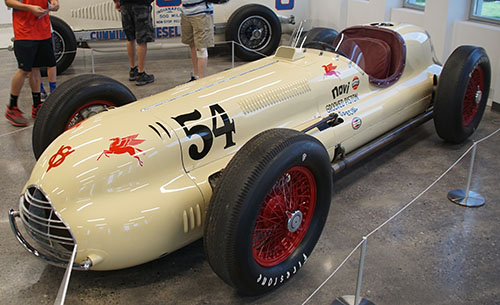
This (front-wheel-driven!) Novi built in 1947 had a fuel tank of over 425 litre capacity in 1948 in order to enable it to get through the 500 miles with a single stop for fuel and fresh tyres. Driver Duke Nalon got close to pulling it off if not for yet another strike of the Novi jinx. By the way, partly visible in the background, the 1931 Cummins Diesel was the first ever car to do the entire 500 Miles non-stop from start to finish. (photo HG)
Anyway, apparently without pitstops and time to receive any strategic instructions, Michel appears on his own in the race. His race starts disastrously. No qualifying spot is given for him but he starts at the front of the field. After a hectic start, however, he is dead last after two laps. Then he manages to squeeze his way through some crashed cars, only to be lapped instantly by Steve. But then he follows Steve and with 50 laps to go, although still one lap down on race leader Steve, he is in fourth place. With 50 laps to go Michel attacks Steve and leaves him behind before with eight laps remaining he has almost made up all of the ground lost to catch Warson with three laps to go. He then overtakes Steve on the straight (more about that feat later) who tries to follow but then his engine blows, handing Michel the victory. A feat unseen since 1927, a rookie winning the race on his first-ever attempt at Indy.
The most questionable aspect of Michel's strategy is that within 47 laps he manages to make up an entire lap on Steve. With laps taking about 65 seconds at that time, it implies that Michel had to drive almost 1.5 seconds per lap faster that Steve, with a heavily underpowered hybrid F1 car, on tyres that have been used since the start. And this is assuming that Steve was still driving a healthy car, if not fast enough to keep up with the flying Vaillante. Anyway, it is only a story but Graton is stretching it big time in this race.
At least he made it a Phyrric victory. Once across the finish, the engine in the victorious Vaillante is entirely done and spent, the reason why a new F1 Vaillante appears in the next F1 race.
If there is one part in the entire album about which one could say that Jean Graton underestimated the truth, it is the competitiveness of a contemporary F1 car modified to some extent against Indycars on their own playground, the Indianapolis Motor Speedway.
For the time being, let's close the Indy part of Le Grand Défi and switch to the other main event in the album and the cars used by the two opponents in that race.
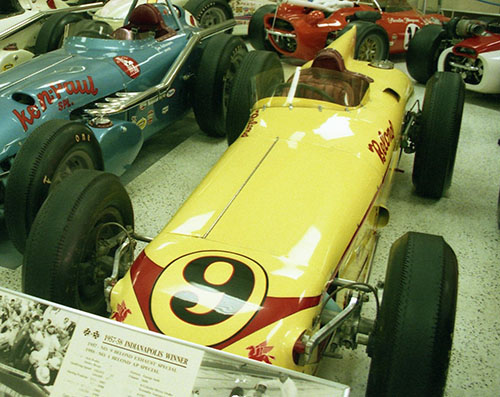
Regardless of the question whether Le Grand Défi took place in 1957 or 1958, the Vaillante Grand Prix had won an Indy 500 that in reality was won by this particular car, the Belond Special. In 1957 it was driven by Sam Hanks, in 1958 by Jimmy Bryan. Seen here in 1988, the car is restored in its 1957 colours. The Belond is one of four cars that has won the Indy 500 twice. (photo HG)
Le Grand Défi continues after Indianapolis
Indianapolis is the first of two non-F1 events in Le Grand Défi, the Le Mans 24 hours is the other one. And again Graton is out of luck when it comes to providing Steve Warson with an American-built sportscar that is seriously competitive. Some US-built sportscars ran locally but the years in which Le Grand Défi takes place are the vacuum years in between the last of the efforts by Briggs Cunningham with his Cadillac-powered specials and the arrival of the earliest seriously competitive versions of the Chevrolet Corvette. Again, Graton provides Steve with a British-built car, the Lister-Jaguar, which indeed existed at the time but never set Le Mans on fire. What the car has going for it is that the Lister-Jaguar has less of a 'bare to the bone British' image like the genuine Jaguars or Aston Martins of the day.
Steve's team mate for the race is a man named Bob Hertman, described as a helping hand to Warson. He is shown on one occasion when he meets the Vaillants in the office of Father Vaillant's friend Louis Latour. There is, however, no clue if he is one of the crew members who was with Steve in the first two races. He did not resemble any of the crew members shown up until that moment.
Hertman tells that Steve is already at Le Mans and we see a drawing of Steve in his Le Mans car. The remarkable thing about that, however, is that if we follow the timeline from the moment that Hertman meets the Vaillants to the start of the race, there is still at least more than a week to go to the race. So how Steve can be seen driving his car at what is in all likelyhood Le Mans? Because in the real world, parts of the track belonging to the public roads were often not available for additional testing apart from the Le Mans test weekend. Anyway, this is definitely a freedom that Graton permitted himself to make the story more logical and acceptable.
Jean Graton had drawn Le Grand Défi during 1957 but curiously, while the adventure was printed in the weekly magazine Tintin, Steve’s Le Mans car all but became reality in the real world.
The aforementioned Briggs Cunningham fielded Lister-Jaguars in the very late fifties in the US sports car world, and gained reasonable results over there, but had not entered the cars at Le Mans yet when Le Grand Défi was printed. In Le Grand Défi there is no single reference that Warson's Lister-Jaguar has the slightest or remotest link with the Briggs Cunningham team. Warson's car certainly does look very much like a real Cunningham-entered Lister that was used from 1958 on.
One of these Cunningham Lister-Jaguars went up for auction in 2017. Pictures of the car were released in an article on the Hemmings.com website that was published on June 30th, 2017. Since no copyright holders for the pictures are given I restrict myself to reproducing one of these pictures.
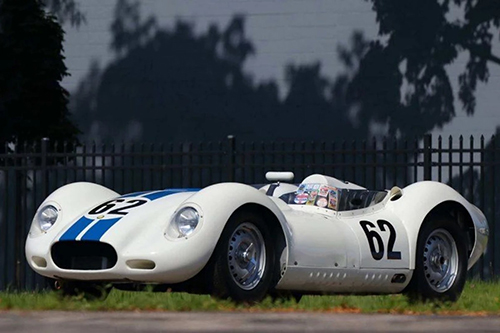
One of the two Briggs Cunningham Racing-operated Lister-Jaguars as it appeared in 2017 when put up for sale.
Only the Ferraris were there to consider as a seriously competitive alternative to the Lister and other British cars. Ironically, 1958 was the first year of the North American Racing Team, a team that promoted the sales of Ferrari road cars by racing Ferraris in the biggest endurance events of the year. However, the team had yet to build its reputation, so was not an option for providing a car and support to Steve Warson. The Lister appears to be a suitable option, and Jaguar in particular had been a force to reckon with at Le Mans during the fifties. So by providing a Lister-Jaguar to Steve, Graton at least gave Steve a car that contained some proven components.
Michel would race at Le Mans together with his brother in a car built by his father's company. The car, at least to me, doesn't resemble any of the contemporary cars, with perhaps a bit of Aston Martin influence at best.
Jean-Pierre Vaillant, Michel's brother and teammate at Le Mans, discovers shortly after returning from the US (Indy) that the cars' front aerodynamics are at fault during a test drive. In record time, as Le Mans takes place less than three-and-a-half weeks after Indianapolis, a new body is created. Similar to what can be retrospectively designated as 'Type 1', I can't find any direct inspiration from cars built in that era for this new 'Type 2' machine, but maybe some specialists with knowledge of the various manufacturers of the era as well as Le Mans (and sports car) specialists may point out a few. (By the way, this unraced 'Type 1' appears on the inside cover of the English edition of Le Grand Défi and is said to be from 'Le Mans '59'.)
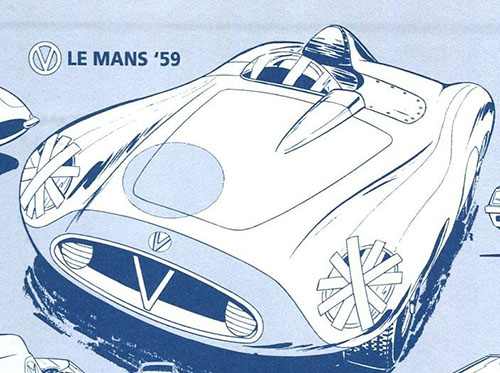
Scan of a part of the inside back cover of The Great Challenge, the English translation of Le Grand Défi, published in 2007. The car appears in the actual adventure too (being rebodied for Le Mans) but this is the first and only reference to this car that I have found for this car (and thus the Grand Défi adventure) being of 1959 heritage.
This pretty much rounds off what I can think of concerning the cars that appear in Le Grand Défi by either Michel Vaillant and Steve Warson when using the actual album and actual history.
More about the Vaillantes in Le Grand Défi, 50 years on
For more about some of the cars discussed, we had to wait until around 2010 when Michel's imaginary cars truly took shape and evolved into more than mere drawings. Around 2008, French publishing company Altaya started to release a collection of 1:43 scale model cars of cars that appeared in the Michel Vaillant comic books. Think about that! Creating a series of model cars of machines that only existed on paper!
Over time, the series contained a total of 50 different models of all kinds of Vaillantes as well as some of the cars that were driven by opposing drivers and teams in several albums. As far as I can figure out, only two cars in the series are based on cars that truly existed. In the closing stage of the series the collectors were pleased with models of the Vaillante 'Grand Prix' as it appears in Le Grand Défi at Indianapolis as well as the two (the unraced 'Type 1' and the 'Type 2' that was raced) Vaillante Le Mans cars.
With the models came a booklet in French with background info about the series, the album of the series in which the modelled car appeared and even some technical details about the car. From the booklet that came with the model, we learned that the Vaillante 'Grand Prix' was raced in 1958. The most important technical details given for the car were: straight-six engine, a bore-and-stroke of 84x75mm for 2492cc, three double carburettors of 45mm producing 260hp at 7500rpm, a 5-speed gearbox, weighing in at 600kgs, a fuel tank capacity of 180 litres and a top speed of 285kph. The booklet confirms the fact that for shape and figure the Vaillante Grand Prix is inspired on the Gordini F1 cars. In fact, the booklet provides additional information about Gordini and how that car manufacturer and its founder inspired Jean Graton.
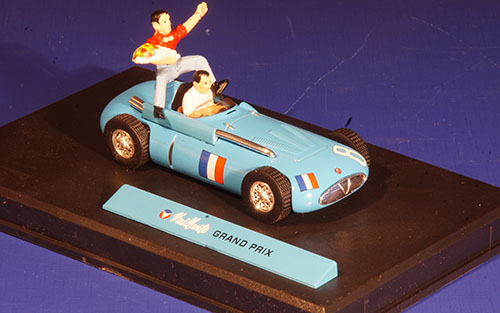
The Vaillante Grand Prix in Indianapolis trim as an Altaya model. The number on the car matches that of the car used in the Indianapolis part of the story. (photo HG)
Using the booklet that came with the model, these are the details about the Le Mans Sport 'Type 2' that was actually raced. This car had a straight-six engine with single overhead camshaft, a bore-and-stroke of 88x82mm for 2990cc, rated at 260hp at 6700rpm, fitted with three double carburettors, a 4-speed gearbox, weighing in at 970kgs, and with a top speed of 280kph. (By the way, based on these data, it would not have made much sense for the Vaillants to fit the Indy Vaillante car with the engine from the 'Le Mans Sport' in a plan similar to what Mercedes had in mind for 1956. Unlike the Mercedes car, the Vaillante Le Mans engine was less sophisticated that the GP car's engine and despite a larger capacity was just as powerful as the standard GP engine.)
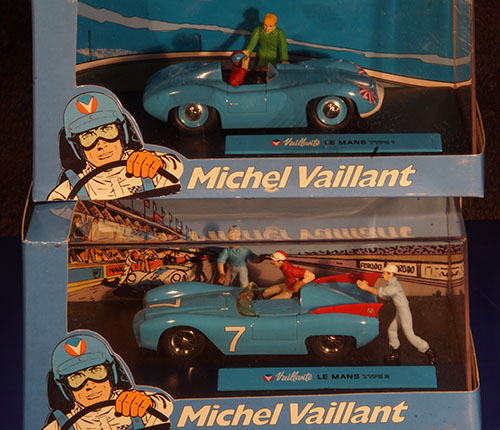
The Altaya models of the two Vaillante sports cars appearing in the album, the unraced original version (top) and the car that was eventually raced (below). (photo HG)
Let's leave at that for the Vaillante cars, at least for the time being…
Some more observations about the Indy part and the timeline in the album
Any other details in Le Grand Défi that caught my attention? Oh certainly.
The first event held in Argentina is unspectacular if it comes to track facilities, which may well have something to do with the rather simple drawings on the album's first pages. The quality of drawing improves quite a bit after the second event (Indianapolis) and these later events in the adventure are more realistic and inspired on the actual conditions.
There is more to tell about what Graton made of Indianapolis, its facilities in particular. When you see the drawings of the race, the pits complex at Indy resembles that of the Le Mans track at that time, a covered cabin where the crew resides and above that a grand stand. On top of that, there is no separation between the actual track and the pitlane. The true situation at Indianapolis was, however, entirely different.
After the 1956 race, the front straight had been massively reworked. Up until that year the pit area had indeed been almost part of the actual track bit apart from a wall, there was no crew protection and certainly no cabin-like structure to retreat to. However, after the 1956 race, the Speedway management created a new pitlane much further away from the actual track, into the infield. It came with a pitlane separated from the track by a wall with on the pitlane side a little grass strip where mechanics could stand to give signals to the drivers passing by. In the process of rebuilding the track, the old wooden timing and scoring building ('the pagoda') had been flattened and in its place a new concrete building (which became known as 'the tower') was erected. At the time, these were truly state-of-the-art facilities. Nothing of the sort can be seen on Graton's drawings. Even the lone aerial overview of the Speedway that Graton drew for Le Grand Défi shows nothing of the new track lay-out.
Graton did predict one part of what the future had in store for the Speedway because eventually, shortly before the millenium change, part of the grandstands behind the new pit facilities were torn down and a complex of pit building facilities with a grandstand on top was indeed created. This section became part of the pitlane structure known since the mid-fifties. These facilities were built to accommodate the Formula One race that was held at Indianapolis between 2000 and 2007. This pit building complex has never been used for either the Indianapolis 500 or the Brickyard 400 events.
Another difference between Graton's Indy event and reality is that in Le Grand Défi Michel and Steve were two of the 32 starters in the race, The real races have had 33 drivers in the race since 1948. (For the knitpickers: 35 in 1979 and 1997, but let's not get into all that.) Those were the 33 fastest qualifiers among an often much larger entry for the race. By creating a starting field of 32 cars, one less than the maximum allowed, Graton prevented Michel from failing to qualify with his tiny underpowered modified F1 car against a legion of specialised Indy roadsters that usually arrived in much larger numbers!
Had Le Grand Défi indeed taken place, the imaginary Indianapolis 500 Record Book would have had some bewildering records added.
I have tried to avoid giving away too many details about the outcome of the events in the album. The one I did give away, although not with the intention of doing so, was the race at Indianapolis. There was a commemorative poster featuring the Vaillante that ran at the Speedway in (supposedly) 1957 appearing in Rodéo sur 2 roues for good reasons: it was the winning car. With that knowledge in mind, there is a lot to tell about this outcome and the consequences for the Indianapolis 500's historical records if anything like what happened in Le Grand Défi had indeed taken place.
To start with, it is obvious that the Vaillante had the smallest engine of all cars competing in the race, even smaller than the 2.8 litres to which supercharged engines were restricted at the time. I know of at least two occasions in which an Indianapolis 500 was won by a car with the smallest engine in the field, and this difference between the winning engine and the majority of the other engines was significant too. Those years are 1930 and 1951. The rules for the 1930 race are so bewildering that I won't go deeper into that one here, but in 1951 the race was won by a car that had a 4-litre Offenhauser instead of a 4.5-litre Offy. (I ignore the 2.8-litre Novis as the smallest engines in the race because of their superchargers!) However, the chances of a car winning the race with an engine that gave away no less than 1.7 litres against its most serious opponents, so not even having 60% of the capacity available to its opponents? I don't think that scenario is a likely possibility.
Another reason why the Vaillante would make it into the imaginary Indianapolis 500 record book is also engine-related. The Vaillante had a straight-six engine but until the release of the album (1959, remember), there had been only two races at Indy when the winning car was powered by a straight-six engine: the very first one in 1911 and the very first one after the war, in 1946. Every other race was won by inline fours and/or inline eights. The Vaillante would have been the third-ever winner with a six-cylinder engine.
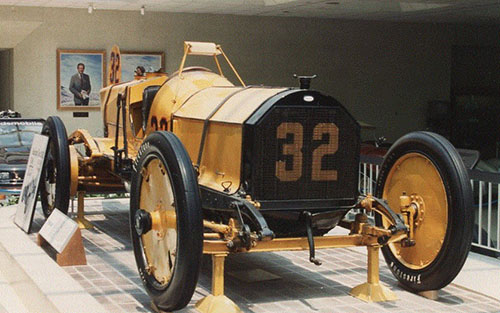
The Marmon Wasp driven by Ray Harroun was the very first winner of an Indy 500 and the first winner with a six-cylinder engine. (photo HG)
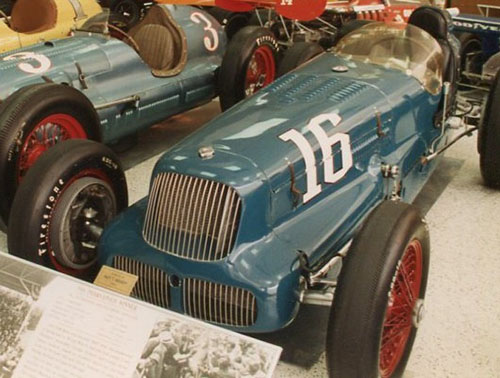
This Thorne Engineering Spcl driven by George Robson was the winning car in the first post-war Indy 500 and the second car ever winning the race with a six-cylinder engine. (photo HG)
As already mentioned before, Michel would have made the record book as one of very few drivers who won their first-ever Indy 500, since that had not been achieved by a driver since 1927 when George Souders performed such a feat. He also would have made the records for being the first non-American to win the race since Dario Resta in 1916. If it comes down to historical racing achievements in general, Michel would have made the headlines by being the first driver to win two events belonging to one of the versions of the Triple Crown - and within a single calendar year! In reality, winning both Indianapolis and Le Mans in the same calendar year had never been done before, and we would have had to wait until 1967 when none other than AJ Foyt was the first (and till date only) driver ever who managed to actually do what Michel achieved in Le Grand Défi.
Vaillante would also have become the first European car builder to win at Indianapolis since the second and last victory with a Maserati 8CTF driven by Wilbur Shaw in 1940. Besides that, there are not that many constructors that participated in the Indy 500 and won the first Indy 500 that they started in. Altogether, if Graton's race had taken place, it would have remained one of the most memorable editions in the entire Indy history.
Something else that Graton drew as taking place during 'his' Indy 500 is Michel overtaking Steve on the straight by sheer top speed, but it was absolutely unheard of that a lighter yet massively underpowered car (having only little over half the power of its opponent!) could overtake a healthy Novi on the straight at Indy. The Novis were for a long time the undisputed kings of the straights at Indy with the highest top speeds recorded. The first time that another car managed to pass a healthy Novi on the straights, curiously enough, was in 1957! But that was not because of this car having a higher top speed, as the Novi in question was passed because of its rival carrying a higher cornering speed, meaning that it had to slow down less than the Novi before the corner so the driver overtook the Novi just before entering the turn. (For the record, it was eventual winner Sam Hanks in the Belond Special who pulled off this achievement.)
Due to the Novi's much higher weight (over 900kg, 260 of those from the engine alone!), they were rarely a match for their opponents in the corners. The straights, however, were their kingdoms. So the scene of a lightly modified 2.5-litre Grand Prix car overtaking a Novi on an Indy straight on sheer top speed was indeed only possible on paper, such as the paper in a comic book.
Maybe it is because I have better knowledge of Indianapolis in the mid and late-fifties than I am familiar with the other events and racing categories that appear in Le Grand Défi, but at least for me, the most comments I can make about any part of the album Le Grand Défi is the Indianapolis part. But given how little was known about Indy at that time in Europe, this should not come as a surprise.
Jean Graton created one more noteworthy Indy-related fantasy. Once the Vaillante team arrives in the US, they meet Steve Warson for the very first time. After refusing to shake Michel's hand Steve leaves the Vaillants standing to drive off in a big American convertible wearing decorations that suggests that it has been a Pace Car at Indianapolis. Such could indeed have been possible as it was a tradition at Indianapolis that the winner also got the Pace Car as one of the prizes. Steve is told to be an Indy winner so he could have driven a former Indy pace car. But whatever pace car Steve has won, there are two reasons why he (and any of the true Indy champs too) never could have won the car that he actually drives.
As Le Grand Défi must be either a 1957 or 1958 adventure, Steve could only have driven a car of 1956 or earlier, or the 1957 car. Instead, however, he drives a car that was introduced to the public in the second half of 1957 but was only offered for sale from 1958 on. Now, it is a fact that several Indy pace cars have been early pre-production versions. Most illustrious of these cars are the 1964-1/2 Mustang (the very first version of the Ford Mustang) and the 1991 Dodge Viper (one of 11 prototypes). So if pushed hard, there is a chance that the car chosen by Graton could still have been a Pace Car in real life.
However, if there is one late-fifties production car built in the US that was most unlikely to be chosen to be the pace car at Indy (or anywhere else for that matter) it was the car used by Jean Graton. The car Graton selected for Steve's transportation was the convertible version of the Edsel, a newly introduced sub brand of the Ford Motor Company, The Edsel is probably the biggest PR and production car failure in the history of the Ford Motor Company, heavily criticized for (among other reasons) its design of frontal view which was much too reminiscent of a certain part of the female anatomy. Now had this been the most eye-catching typical female feature, the one that helped movie stars like Mae West and Jayne Mansfield gain their reputation, Ford may have got away with it eventually, maybe after a facelift that downplayed the similarity. But the drawing made by Graton for Le Grand Défi already hints to the Edsel being fitted with a radiator ornament that resembled that other, even more exclusive female organ to an amount that was too much for many to feel comfortable with...
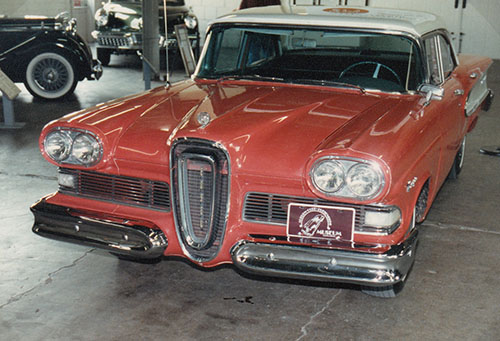
A sedan version of the Edsel I saw in 1991. The front part is almost 100% identical to that used on the convertible that inspired the Pace Car that Steve Warson drove for personal transport in Le Grand Défi. (photo HG)

A cover of the Tin-Tin magazine, printed in February 1958 that contained an episode of Le Grand Défi. This cover was drawn by Jean Graton but the drawing did not appear in the final adventure. Looking so innocent, but would this drawing have made the front cover of any magazine of its kind today? (copyright unknown)
Anyway, Edsel production was cancelled in 1960 and the Edsel convertible was never used as a Pace Car.
There are a few more things that may cause some wonder about the plot of Le Grand Défi as Graton worked it out. I mentioned one of them briefly already but will go into more details here.
With Indianapolis held on May 30th, that day was near the end of the week in both 1957 and 1958, in 1958 May 30th was a Friday. Le Mans took place a little more than three weeks later in both years.
Now, if Jean Graton had stuck to the actual sequence of events as they took place in reality, then in those three weeks' time he had the Vaillant family first return to France, and then Jean-Pierre finds out a few days after the Indianapolis race that the aero package on the intended Le Mans car is not right. So he rushes to design a new bodywork shape that has to be finished in less than three weeks because Le Mans is held by then! On top of that, he is also present at Francorchamps when the third event for Le Grand Défi is held over there. The real Belgian GP of 1958 took place the weekend before the Le Mans 24 Hours. And once back from the US, a new F1 car had been built as well in order to compete in that Belgian race, replacing the car that was used up at Indianapolis.
After the F1 race in Belgium, the rebodied Vaillante Le Mans is delivered and less than a week later the car has raced at Le Mans. Somehow that entire scenario from the moment that the Vaillants return to France looks a bit too unlikely to be possible, even in that time.
It becomes an even more bewildering scenario when after the third and fourth event (the Belgian GP and Le Mans) the last event (the German GP) comes up and we see the Vaillante team during a meeting on the eve of that last event, with its date listed as June 2nd, three days after the race at Indianapolis! This is most definitely a date mix-up since assuming that Le Grand Défi took place in 1958 the German Grand Prix was held at August 3rd that year. If we follow Graton's sequence of events as they happen over time, there are a few periods of time in between events in the story that lack information about how long they lasted. But from what I can make upg, the time frame between the races at Indianapolis and Le Mans is at least four weeks, if not five and maybe even six weeks. Again, a deviation from the actual situation in order to make the scenario plausible and as such, it works.
If I am picky, I could bring up more differences between the comic book and the truth, and maybe some other errors too if I keep searching for them. But should I do so I fear it would make me look even more negative on Jean Graton and his work. Although it may appear as if I am negative about Le Grand Défi because of this article, I am not negative about either Jean Graton or his album(s) and I won't be. I am one of the few people in this world who has no right to blame Le Grand Défi for anything because I am one of the few people who can say that they owe some unforgettable moments and events in their lives to Le Grand Défi.
Dear reader, please read all those differences between album and reality as observations, not as criticism. I only tried to describe the differences and try to tell what reality was like compared to what Graton made up. Even without my personal gains in life that I owe to the album, I rate Le Grand Défi as one of the best of the stories in the entire Michel Vaillant series. In fact, because it was such a good story, it would become the album that warranted the continuation of the series and made Graton a well-respected author and the 'father' of a series that is still going strong, now for more than 60 years. An achievement that is to be respected for any comics series.
Monsieur Graton, chapeau et merci beaucoup pour votre histoire Le Grand Défi.
Then, finally. Dear Reader, perhaps you feel that I have given quite some attention (if not too much?) to the Indianapolis part in the story and the genuine Novi cars as they were, as well as Steve Warson's Novi as drawn by Jean Graton. I can't deny the fact that from the moment I first had seen anything about Indianapolis and the Novi I was fascinated by both. You may guess three times what the first moment was that I found out about Indianapolis, and what the first Novi of any kind was that I ever set eyes upon in my life, and consequently the one that started the ball rolling that represents my passion for the Novi and all that this passion has brought to me ever since.
Par conséquent, encore une fois merci, monsieur Graton, encore une fois merci beaucoup.
References
Publications
Dutch translations of the Michel Vaillant albums:
No. 1: Le Grand Défi (an English translation of this album released in 2007 was also used)
No. 20: Rodéo sur 2 roues
Floyd Clymer's Indianapolis 500 and Monza 500 Yearbook 1957
Novi, the Legendary Indianapolis Race Car. Volume One: The Welch Years (1941-1960), by George Peters & Henri Greuter, Bar Jean Enterprises, Hazelwood, MO (1991)
The Illustrated History of the Indianapolis 500 1911-1994, by Jack C. Fox, Carl Hungness Publishing, Speedway, IN
Autocourse History of the Grand Prix Car 1945-65, by Doug Nye
Les voitures de Michel Vaillant, no 39: Vaillante Le Mans Type 2, Le Grand Défi
Les voitures de Michel Vaillant, no 42: Vaillante Grand Prix, Le Grand Défi
These were booklets released with the 1:43 scale model of the listed car, released by Altaya France. Apart from a description about the actual car, booklet no 39 also contained more details about the album Le Grand Défi and its origins.
Websites
Michel Vaillant on Wikipedia
Vaillant fan club
Official Michel Vaillant website
Hemmings.com
I also consulted Wikipedia for the Formula One seasons of 1957 and 1958, as well as for the Le Mans races of the same years.
I also had private correspondence with Mr Jean Graton regarding the Novis he used in his albums, among them the 'Big White 1' that appears in Le Grand Défi.
Thanks to Mr Mark Pethke from Baton Rouge, Louisiana, USA for his assistance in obtaining more relevant information about the Lister-Jaguar to be included in this article.
